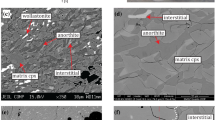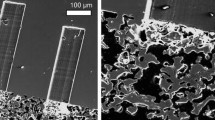Abstract.
Volume diffusion rates for five rare earth elements (La, Ce, Nd, Dy, and Yb) have been measured in single crystals of natural diopside at pressures of 0.1 MPa to 2.5 GPa and temperatures of 1,050 to1,450 °C. Polished, pre-annealed crystals were coated with a thin film of rare earth element oxides, then held at constant temperature and pressure for times ranging from 20 to 882 h. Diffusion profiles in quenched samples were measured by SIMS (secondary ion mass spectrometry) depth profiling. At 1 atm pressure, with the oxygen fugacity controlled near the quartz–fayalite–magnetite buffer, the following Arrhenius relations were obtained for diffusion normal to (001) (diffusion coefficient D in m2/s): log10 D Yb =(–4.64±0.42)–(411±12 kJ/mol/2.303RT); log10 D Dy =(–3.31±1.44)–(461±41 kJ/mol/2.303RT); log10 D Nd =(–2.95±2.64)–(496±77 kJ/mol/2.303RT); log10 D Ce =(–4.10±1.08)–(463±31 kJ/mol/2.303RT); log10 D Lu =(–4.22±2.66)–(466±78 kJ/mol/2.303RT).
Diffusion rates decrease significantly with increasing ionic radius, with La a factor of ~35 slower than Yb. The relationship between diffusivity and ionic radius is consistent with a model in which elastic strain plays a critical role in governing the motion of an ion through the crystal lattice. Activation volumes for Yb and Ce diffusion, at constant temperature and oxygen fugacity, are 9.0±2.0 cm3/mol and 8.9±3.2 cm3/mol, respectively, corresponding to an order of magnitude decrease in diffusivity as pressure is increased from 0 to 3 GPa at 1,200 °C. Diffusion of Nd is such that grain-scale isotopic equilibrium in the mantle can be achieved in ~1 My under conditions near the peridotite solidus (~1,450 °C at 2.5 GPa). The equilibration time is much longer under P, T conditions of the lithospheric mantle or at the eclogite solidus (~1 Gy at 1.5 GPa and 1,150 °C). Because of the relatively strong decrease in diffusivity with pressure (two orders of magnitude between 2.5 and 15 GPa along an adiabatic temperature gradient), Nd transport in clinopyroxene will be effectively frozen at pressures approaching the transition zone, on time scales less than 100 My. Rare earth element diffusion rates are slow enough that significant disequilibrium uptake of REE by growing clinopyroxene phenocrysts may be preserved under natural conditions of basalt crystallization. The relative abundances and spatial distributions of REE in such crystals may provide a sensitive record of the cooling and crystallization history of the host lava.
Similar content being viewed by others
Author information
Authors and Affiliations
Additional information
Electronic Publication
Rights and permissions
About this article
Cite this article
Van Orman, J.A., Grove, T.L. & Shimizu, N. Rare earth element diffusion in diopside: influence of temperature, pressure, and ionic radius, and an elastic model for diffusion in silicates. Contrib Mineral Petrol 141, 687–703 (2001). https://doi.org/10.1007/s004100100269
Received:
Accepted:
Issue Date:
DOI: https://doi.org/10.1007/s004100100269




